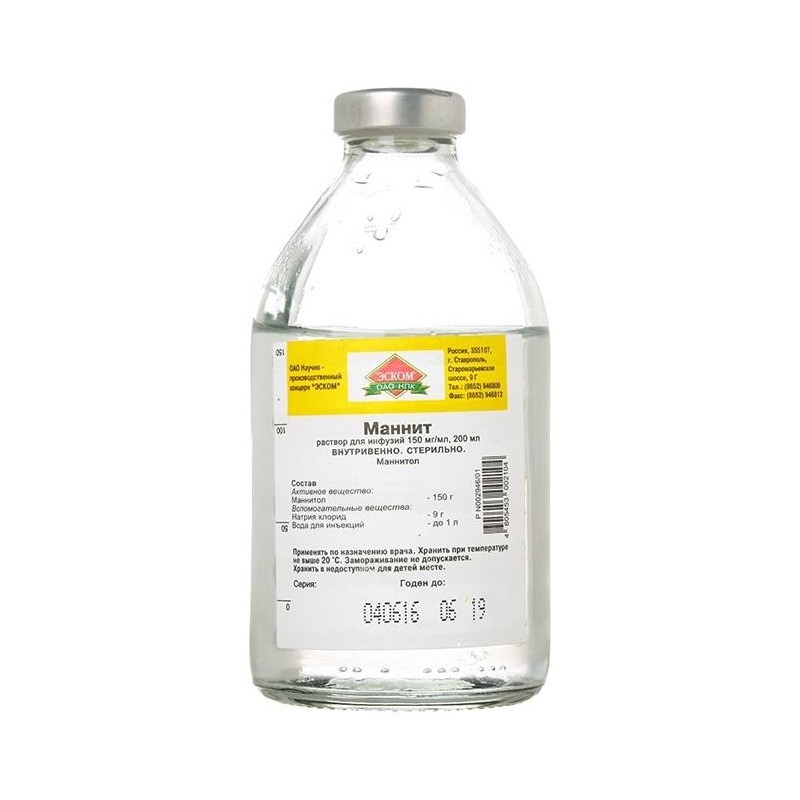



Mannitol is an osmotic diuretic. The theoretical osmolarity is 1132 mosm / l. By increasing the osmotic pressure of the plasma and filtering without subsequent tubular reabsorption leads to retention of water in the tubules and an increase in urine volume. Increasing the osmolarity of blood plasma, causes the movement of fluid from the tissues (in particular, the eyeball, brain) into the bloodstream. Does not affect glomerular filtration. Diuresis is accompanied by a moderate increase in natriuresis without a significant effect on the excretion of potassium ions. The diuretic effect is higher, the greater the dose.
Not effective in violation of the filtration function of the kidneys, as well as in azotemia in patients with cirrhosis of the liver and ascites. Causes an increase in circulating blood volume.
Active ingredient: mannitol - 150 g;
Excipients: sodium chloride - 9 g, water for injection - up to 1 l.
Mannitol is marketed under different brands and generic names, and comes in different dosage forms:
| Brand name | Manufacturer | Country | Dosage form |
|---|---|---|---|
| Mannitol | Escom NPK | Russia | solution |
| Mannitol | Kraspharma | Russia | solution |
No customer reviews for the moment.
Intravenous, slow jet or drip.
The prophylactic dose is 0.5 g / kg, therapeutic - 1–1.5 g / kg; daily dose should not exceed 140-180 g.
Before the introduction of the drug should be heated to a temperature of 37 ° C (can be in a water bath).
During operations with artificial blood circulation, the drug is injected into the device at a dose of 20–40 g immediately before the start of perfusion.
Patients with oliguria should be previously introduced into / into the drip test dose (200 mg / kg) for 3-5 min. If after this there is no increase in the rate of diuresis to 30–50 ml / h for 2–3 h, then it is necessary to refrain from further administration of the drug.
Dehydration (dry skin, dyspepsia, myasthenia, seizures, dry mouth, thirst, hallucinations, lower blood pressure), impaired water and electrolyte metabolism (increased BCC, hyponatremia; rarely - hyperkalemia).
Rarely - tachycardia, chest pain, thrombophlebitis, skin rash.
Carefully: pregnancy, lactation, old age.
Perhaps the increased toxic effects of cardiac glycosides (associated with hypokalemia).
During pregnancy and lactation, use the drug only in cases where the intended benefit to the mother exceeds the possible risk to the fetus or infant.
For left ventricular insufficiency (due to the risk of pulmonary edema), mannitol should be combined with fast-acting loop diuretics. Control of blood pressure, diuresis, electrolyte concentration in serum (sodium, potassium ions) is necessary.
If a headache, vomiting, dizziness, visual impairment appears during the administration of the drug, the administration should be stopped and the development of such complications as subdural and subarachnoid bleeding should be excluded.
It can be used in heart failure (only in combination with loop diuretics) and hypertensive crisis with encephalopathy. Re-introduction of Mannit should be under the control of indicators of water and electrolyte balance of blood.
Possible cases of crystallization of the drug during storage (at temperatures below 20 ° C). In the case of crystallization, the bottle is heated to 50–70 ° C until the sediment is dissolved. Used after cooling to body temperature, if the crystals do not fall out again.
Studies and clinical trials of Mannitol (Click to expand)